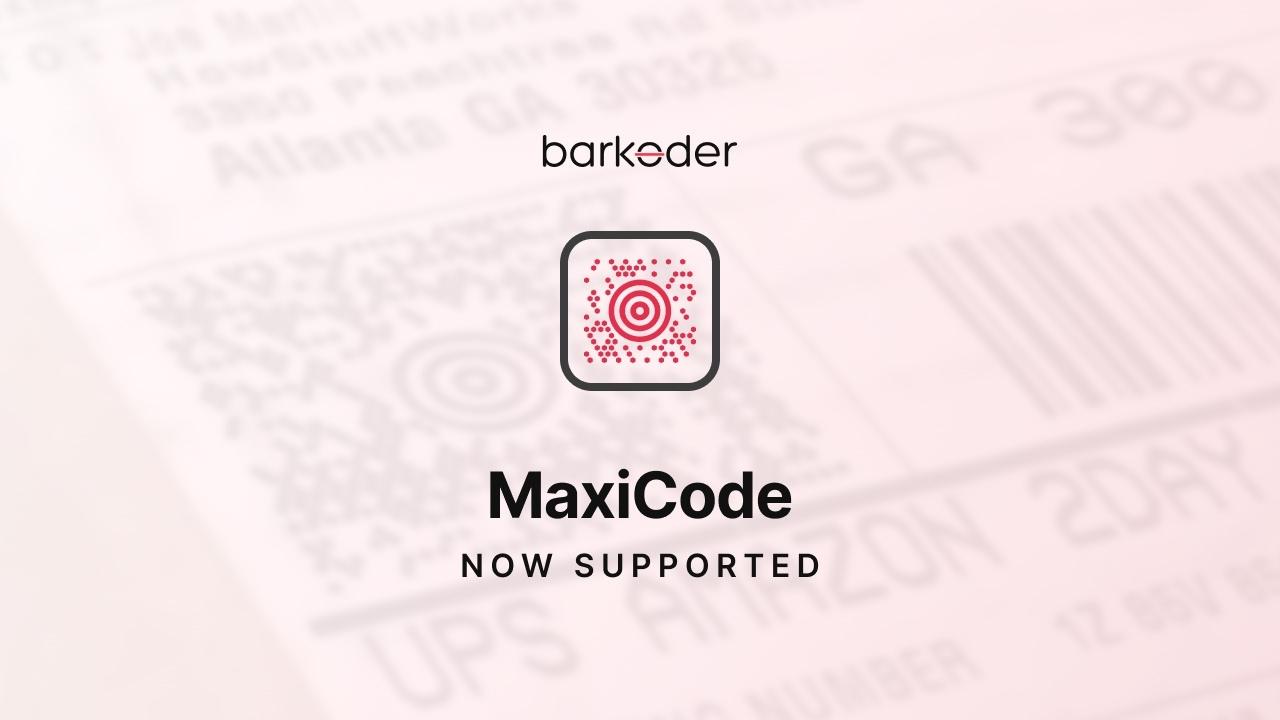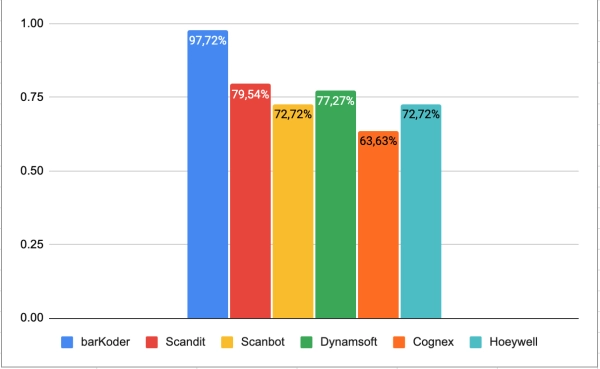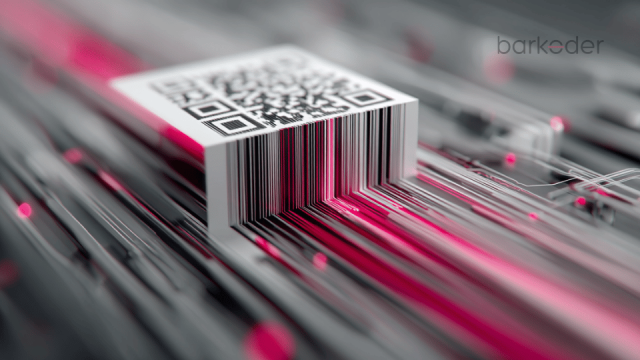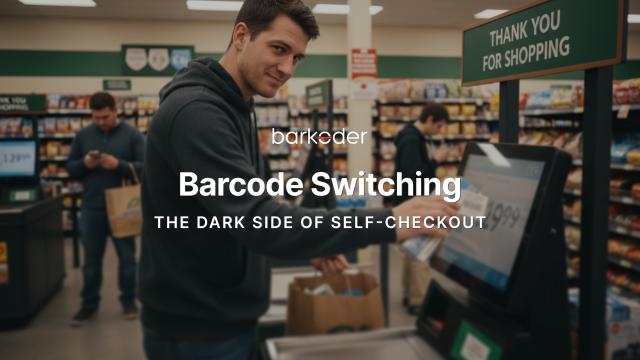
barkoder Update: Now Supporting MaxiCode!
We're excited to announce that barKoder has just added support for a powerful new barcode symbology—MaxiCode!
MaxiCode is a two-dimensional, circular barcode symbology developed by United Parcel Service (UPS) in 1992. It was specifically designed to enhance parcel tracking and streamline package delivery operations.
Often referred to as the “Bird’s Eye,” “Target,” “Dense Code,” or “UPS Code,” MaxiCode features a fixed size of approximately one inch square. It consists of hexagonal modules arranged in a grid around a central bullseye pattern, allowing for rapid and accurate scanning—even on moving packages.
MaxiCode supports the full 256-character ASCII set, although it has a lower data capacity compared to other 2D matrix codes such as QR Code and Data Matrix. Each MaxiCode symbol can hold up to 93 alphanumeric or 138 numeric characters, making it ideal for encoding essential address and tracking information.
One of its key features is Structured Append, which allows up to eight MaxiCode symbols to be linked together. This enables the encoding of larger data sets while ensuring accurate reconstruction regardless of the order in which the codes are scanned.
A MaxiCode symbol is divided into two parts:
Primary Message: Encodes the postal code, a 3-digit country code, and a 3-digit service class.
Secondary Message: Contains additional details such as address data and any other necessary information.
MaxiCode also supports multiple operational modes that define how data is structured and how error correction is applied. It uses Reed-Solomon error correction, which allows up to 12.5% of the symbol to be damaged while still remaining readable.
Widely adopted across the logistics and postal industries in the United States, MaxiCode has proven essential for ensuring accurate tracking, efficient package routing, and timely delivery. It conforms to the ISO/IEC 16023:2000 standard, ensuring broad compatibility across systems and devices.
With this update, Barkoder continues to expand its range of supported symbologies, giving developers and businesses even more flexibility and capability when working with barcode scanning and decoding in their apps.
Applications of MaxiCode Across Industries
1. Logistics and Package Tracking
One of the core applications of MaxiCode lies in logistics and package tracking. Companies like UPS have widely adopted this symbology to encode vital shipment details—such as package contents, destination addresses, shipping routes, and delivery schedules. By consolidating this information into a single, compact barcode, MaxiCode streamlines tracking processes and significantly improves operational efficiency.
2. Retail and Inventory Management
In the retail sector, MaxiCode is used to manage inventory and monitor product flow across supply chains. It enables accurate tracking of stock levels, product movements, and inventory turnover. Retailers often encode product information, batch numbers, and expiration dates into MaxiCode symbols, supporting efficient stock management and timely replenishment of goods.
3. Transportation and Ticketing
MaxiCode is also employed in the transportation industry for encoding information on boarding passes, tickets, and travel documents. It stores passenger details, travel itineraries, and security data, enabling faster and more reliable check-in processes. Its high-speed readability and data integrity make it well-suited for busy environments like airports, train stations, and transit hubs.
4. Healthcare and Pharmaceutical Tracking
In healthcare, MaxiCode plays a crucial role in the tracking and authentication of pharmaceutical products, medical equipment, and patient records. It can encode detailed information such as medication names, dosage instructions, batch numbers, and patient IDs. This enhances patient safety, minimizes medication errors, and helps ensure regulatory compliance throughout the supply chain.
Why MaxiCode?
Optimized for fast, high-volume environments
Reliable scanning even at high speeds
Perfect for supply chain and transportation applications
High Data Capacity: Capable of encoding large amounts of data within a compact symbol, maximizing information storage efficiency.
- Error Correction: Robust error correction mechanisms ensure reliable data retrieval and enhance scanning accuracy.
- Versatility: Supports multiple data encoding modes, making it suitable for diverse applications in logistics, retail, healthcare, and transportation.
- Standardization: ISO/IEC standardization ensures compatibility and interoperability across different scanning devices and software platforms.
- Fast Scanning: Hexagonal grid design facilitates fast scanning speeds, ideal for high-volume scanning environments such as distribution centers and retail checkout counters.
Testing is the most critical aspect of barcode scanning SDK
Accuracy and reading rate are vital metrics, especially when it comes to scanning damaged, low-resolution and blurred barcodes often encountered in real-world scenarios, where environmental conditions or wear and tear may compromise their readability. In that regard we conducted a series of tests, with the underlying statistical information and analysis shared publicly in this blog post.
In our pursuit of excellence in terms of mobile & web barcode scanning and to ensure that our barcode scanning SDKs are robust and reliable, we have conducted extensive testing, taking in mind various conditions and environmental factors. Our methodologies involve subjecting our scanners to a wide range of barcode images, including those intentionally damaged, low in resolution, or blurred to a varying degree. Through these rigorous tests, we aim to assess the performance of our technology in adverse conditions in order to try to identify areas for improvement.
The statistical information gathered from these tests provides valuable insights into the effectiveness of the unique barcode scanning algorithms that are part of the barKoder SDK. We analyze factors such as recognition rate, the time taken to scan damaged or blurred barcodes, and the accuracy of the decoded data. By examining these metrics, we gain a comprehensive understanding of our system's capabilities and limitations, allowing us to refine our algorithms and enhance the overall performance.

In addition to the 44 samples of blurred, damaged, conditioned, aged and otherwise altered MaxiCode codes, we also incorporated various lighting conditions, angles, and backgrounds to simulate real-world scenarios. This meticulous approach enabled us to thoroughly evaluate the performance and resilience of our system across a wide spectrum of challenging environments. By subjecting our technology to such rigorous testing, we are confident in its ability to deliver accurate and dependable results, even in adverse conditions. The final result put barKoder with the highest score (97.72%), with Scandit second (79.54%), Dynamsoft (77.27%), Scanbot and Honeywell with the same results (72.72%), and Cognex last (63.63%).
Update to the latest version of barKoder SDK to start using MaxiCode today!






